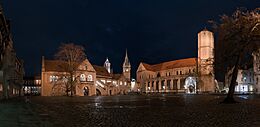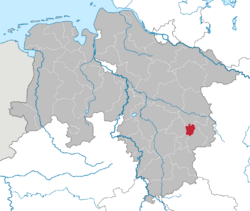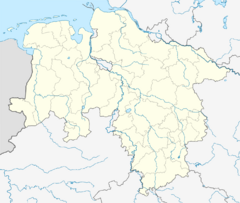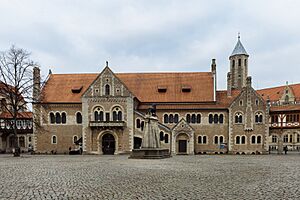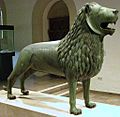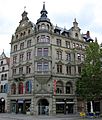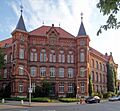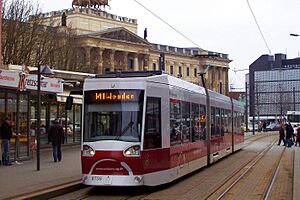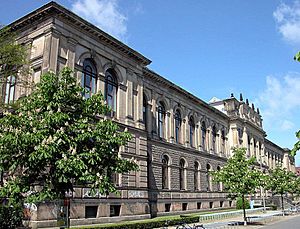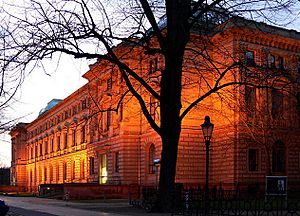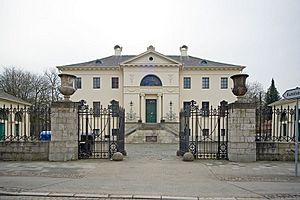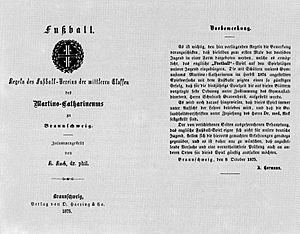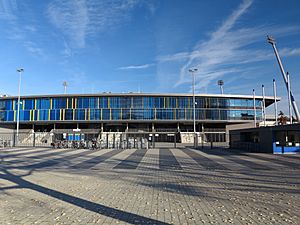Braunschweig facts for kids
Quick facts for kids
Brunswick
|
|||
|---|---|---|---|
|
Clockwise from top: Castle Square with Brunswick Cathedral, Dankwarderode Castle and the Brunswick Lion, Happy Rizzi House, Town Hall, Brunswick Palace, Old Town market with the Church of Saint Martin and the Alte Waage with the Church of Saint Andrew
|
|||
|
|||
| Country | Germany | ||
| State | Lower Saxony | ||
| District | Urban district | ||
| Founded | 9th century | ||
| Subdivisions | 19 boroughs | ||
| Area | |||
| • City | 192.13 km2 (74.18 sq mi) | ||
| Elevation | 75 m (246 ft) | ||
| Population
(2022-12-31)
|
|||
| • City | 251,804 | ||
| • Density | 1,310.59/km2 (3,394.42/sq mi) | ||
| • Metro | 1,150,000 | ||
| Time zone | UTC+01:00 (CET) | ||
| • Summer (DST) | UTC+02:00 (CEST) | ||
| Postal codes |
38100–38126
|
||
| Dialling codes | 0531, 05307, 05309, 05300 | ||
| Vehicle registration | BS | ||
| Website | Braunschweig.de | ||
Braunschweig (also called Brunswick in English) is a city in Lower Saxony, Germany. It's located north of the Harz Mountains, right on the Oker River. This river connects it to the North Sea through the Aller and Weser rivers. In 2016, about 250,704 people lived here.
In the Middle Ages, Braunschweig was a very important trading city. It was part of the Hanseatic League, a powerful group of trading cities, from the 1200s to the 1600s. It was also the capital city for several states, like the Duchy of Brunswick.
Today, Braunschweig is the second-largest city in Lower Saxony. It's also a big center for science and new ideas.
Contents
- History of Braunschweig
- Population of Braunschweig
- Climate in Braunschweig
- Main Sights to See
- Getting Around Braunschweig
- Why So Many Brunswicks?
- Science and Research
- Education in Braunschweig
- Economy of Braunschweig
- Culture in Braunschweig
- Twin Towns and Sister Cities
- Notable People from Braunschweig
- Images for kids
History of Braunschweig
How Braunschweig Began
We don't know exactly when or how Braunschweig started. People say it grew from two small settlements. One was founded by a Saxon count named Brun(o) around the year 861. The other was near a castle called Dankwarderode Castle, named after a legendary Count Dankward.
The name Brunswik might come from Bruno's name and a Low German word wik, meaning a place where merchants rested. This makes sense because the city was built near a place where people could cross the Oker River. The city was first written about in documents in 1031, where it was called Brunesguik.
Braunschweig in the Middle Ages
Until the 1100s, the Brunonid family ruled Braunschweig. Then, the city became part of the House of Welf through marriage. In 1142, Henry the Lion became the Duke of Saxony. He made Braunschweig his capital. He built up the city and made Dankwarderode Castle his home.
Henry also had the Brunswick Cathedral built. He put a statue of a lion, his special animal, in front of the castle. This Brunswick Lion became a famous symbol of the city. Henry the Lion became very powerful. He even married Matilda, the daughter of the English King Henry II of England.
During the Middle Ages, Braunschweig was a major trading hub. It was one of the most important economic and political cities in Northern Europe. It joined the Hanseatic League and stayed a member until the mid-1600s. By 1600, Braunschweig was the seventh-largest city in Germany.
Even though it was part of a larger state, Braunschweig was mostly run by its own powerful citizens and trade groups. The rulers of the Principality of Brunswick-Wolfenbüttel even moved their home out of the city in 1432. They didn't get full control back until the late 1600s.
In the 1700s, Braunschweig became a center for culture and new ideas. Dukes like Charles I supported arts and sciences. In 1745, he started the Collegium Carolinum, which later became the Braunschweig University of Technology. Famous writers like Lessing came to the city. Some important plays were first performed here.
Braunschweig in the 1800s
In 1806, during the Napoleonic Wars, the French took over Braunschweig. It became part of a new kingdom created by Napoleon. The Duke, Frederick William, formed a group of soldiers called the Black Brunswickers to fight the French.
After the wars ended in 1815, Braunschweig became an independent state again, the Duchy of Brunswick. Later, it joined the German Empire in 1871. In 1830, there were protests in Braunschweig. The Duke, Charles II, was forced to leave. His palace was even burned down. His brother, William VIII, took over and brought in more modern changes.
The 1800s also saw a lot of industry grow in Braunschweig. More people moved to the city, and it grew beyond its old walls. In 1838, the first railway line in Northern Germany opened, connecting Braunschweig to Wolfenbüttel.
Braunschweig in the 1900s
After World War I ended in 1918, the Duke of Braunschweig stepped down. A new government was formed. In 1919, there was a small uprising in the city, but it was stopped. Braunschweig became a parliamentary republic within Germany.
In the 1930s, the Nazi Party gained power in Braunschweig. The city became a place where the Nazis held big events. In 1932, Braunschweig even gave Adolf Hitler German citizenship, which allowed him to run for president.
During World War II, Braunschweig was an important center for making weapons. Many factories in and around the city helped with this. Thousands of workers were brought to the city for forced labor. There were also two small camps connected to a larger concentration camp, where prisoners were forced to work or clear rubble.
On October 15, 1944, a big air raid destroyed most of Braunschweig's old town. Many churches and beautiful old timber-framed houses were ruined. Only about 100 of 800 such houses survived. The city's cathedral, however, remained standing.
Braunschweig After the War
After World War II, Braunschweig was no longer a capital city. Most of its land became part of the new state of Lower Saxony. During the Cold War, Braunschweig was close to the border with East Germany. This made it harder for the city to grow economically for many years.
In 1974, the areas around Braunschweig were joined with the city itself. This added about 52,000 people to Braunschweig's population. In the 1990s, people started to rebuild some of the historic buildings that were destroyed in the war, like the Brunswick Palace and the Alte Waage.
Population of Braunschweig
Braunschweig has about 250,000 people, making it the second-largest city in Lower Saxony. It is one of Germany's oldest cities. Braunschweig first reached over 100,000 people in 1890. In the 1960s and 1970s, the population grew a lot because of new car factories and other industries. The city reached its highest population of about 273,000 in 1975.
After the German reunification in the 1990s, the population started to grow again. Many people from East Germany moved to Braunschweig because it was close by. Today, Braunschweig is very focused on research and new ideas. It has one of the highest rates of spending on research and development in Europe!
Religions in Braunschweig
In 2015, about 36.3% of people in Braunschweig were Protestant. About 13.7% were Roman Catholic. The other 50% belonged to other religions or no religion.
People from Other Countries
In 2015, about a quarter of Braunschweig's residents had family roots from other countries. This includes German citizens and non-German citizens. About 10.2% of the population were not German citizens. The largest groups of people from other countries living in Braunschweig in 2022 included:
- Turkey: 4,729 people
- Poland: 3,618 people
- Ukraine: 2,096 people
- Italy: 1,532 people
- Romania: 1,463 people
- Portugal: 1,335 people
- Serbia: 1,308 people
- Spain: 1,283 people
- Greece: 1,185 people
- Syria: 1,031 people
Climate in Braunschweig
Braunschweig has a mild climate. The average temperature for the year is about 9.9 degrees Celsius (49.8 degrees Fahrenheit). The warmest month is July, with an average high of 23.9°C (75.0°F). The coldest month is January, with an average low of -0.7°C (30.7°F).
The city gets about 614.8 millimeters (24.2 inches) of rain each year. July is usually the wettest month. Braunschweig gets about 1692.6 hours of sunshine per year.
Main Sights to See
Braunschweig has many interesting places to visit.
Historical Squares and Buildings
- The Burgplatz (Castle Square) is a very historic area. Here you'll find the Brunswick Cathedral (built in the late 1100s) and the Burg Dankwarderode (a rebuilt castle from the 1800s). There's also the Neo-Gothic Town Hall and beautiful half-timbered houses. In the middle of the square is a copy of the Brunswick Lion statue, which is the city's symbol. The original lion statue is in the castle museum.
- The Altstadtmarkt (Old Town Market) has the Old Town Hall (from the 1200s-1400s) and the Church of Saint Martin (from 1195). You can also see old houses like the Gewandhaus and a fountain from 1408.
- The Kohlmarkt (Coal Market) is another square with old houses and a fountain.
- The Hagenmarkt has the 13th-century Church of Saint Catherine and the Heinrichsbrunnen (Henry the Lion's Fountain).
Unique Buildings and Areas
- The Magniviertel (St Magnus' Quarter) is a charming old part of Braunschweig with cobblestone streets, small shops, and cafes. It's centered around the 13th-century Magnikirche (St Magnus' Church). You can also find the Rizzi-Haus here, a very colorful and cartoon-like office building designed by James Rizzi.
- The Andreaskirche (Church of Saint Andrew) is a beautiful church built between the 1200s and 1500s. Nearby is the Liberei, which is Germany's oldest freestanding library building. The rebuilt Alte Waage is also here.
- The Aegidienkirche (Church of Saint Giles) was built in the 1200s. It has an old monastery next to it, which is now a museum.
- The Staatstheater (State Theatre) is a modern building, but its history goes back to the first public theater in Germany, founded in 1690.
- The Brunswick Palace was destroyed in World War II. Its outside was rebuilt and now holds a museum, a library, and a shopping center. It opened in 2007.
- The Schloss Richmond (Richmond Palace) is a beautiful baroque palace built in the 1760s. It has an English garden around it.
- The BraWoPark is a modern shopping and business center near the main train station. It has tall office towers.
- Riddagshausen Abbey is an old monastery with a nature reserve and a tree garden around it. The nature reserve is important for birds.
- You can also see many historic neighborhoods with beautiful old buildings, like the Östliches Ringgebiet.
Parks and Gardens
Braunschweig has many green spaces to enjoy:
- The Botanischer Garten (botanical garden) was started in 1840.
- Other parks include the Bürgerpark, the Löwenwall (with an obelisk), the Prinz-Albrecht-Park, and the Inselwallpark.
- There are also lakes like Heidbergsee and Südsee.
- You can visit the Arche Noah Zoo Braunschweig or the nearby Essehof Zoo.
Getting Around Braunschweig
The center of Braunschweig is mostly a pedestrian zone, meaning cars are not allowed.
By Road
Two major highways, the A2 and A39, serve Braunschweig. City roads are wide, as they were rebuilt after World War II.
By Bicycle
Many people in Braunschweig ride bikes. There's a big network of bike lanes. The main train station even has a special area for parking bikes.
By Train
Braunschweig is on the main train line between Frankfurt and Berlin. Deutsche Bahn (German Railways) offers local, inter-city, and high-speed InterCityExpress (ICE) trains at Braunschweig Central Station.
By Tram and Bus
Braunschweig has a good tram system that is about 35 kilometers (22 miles) long. It started in 1897 and has been updated. The city also has many bus lines.
There are five main tram lines:
- Tram 1 from Wenden to Stöckheim
- Tram 2 from Siegfriedviertel to Heidberg
- Tram 3 from Volkmarode to Weststadt Weserstraße
- Tram 4 from Radeklint to Helmstedter Straße
- Tram 5 from Hauptbahnhof to Broitzem
- Tram 10 from Hauptbahnhof to Rühme
By Air
Braunschweig Airport (BWE / EDVE) is located north of the city.
Why So Many Brunswicks?
You might have heard of other places named Brunswick, like New Brunswick in Canada. This is because the English name for Braunschweig is Brunswick. Between 1714 and 1837, the House of Hanover ruled Great Britain. This royal family was also known as the House of Brunswick-Lüneburg. So, many places in the British Empire were named Brunswick.
It's interesting that the city of Braunschweig itself wasn't ruled by the Hanoverians during this time! The family had split into different branches. Braunschweig was ruled by the Wolfenbüttel branch, while the Hanover branch ruled Lüneburg. All branches still used the name "House of Brunswick-Lüneburg."
Science and Research
Braunschweig is a very important place for science and research. It has a famous University and many research centers. These include the Johann Heinrich von Thuenen Institute and the Helmholtz Centre for Infection Research. The Physikalisch-Technische Bundesanstalt (PTB) in Braunschweig even keeps the atomic clock that sets the official German time!
In 2006 and 2019, the Braunschweig area was ranked as one of the most research-focused regions in all of Europe. This means a lot of money and effort goes into new discoveries and technology here. In 2007, Braunschweig was even named "City of Science."
The Braunschweig University of Technology was founded in 1745. It's the oldest member of TU9, a group of Germany's top engineering and technology universities. About 18,000 students attend this university.
Education in Braunschweig
Braunschweig has a long history of education. The Martino-Katharineum is a secondary school founded in 1415. Famous people like the mathematician Carl Friedrich Gauss and the poet Hoffmann von Fallersleben went there. Since 2004, Braunschweig also has an International School.
The city is also home to Lower Saxony's only art university, the Hochschule für Bildende Künste Braunschweig (Braunschweig College of Fine Arts).
Economy of Braunschweig
In 2015, a German business magazine called Braunschweig one of the most active economic areas in Germany.
In the past, Braunschweig was known for its canning industry (making canned foods) and railroad industries. Today, other industries are more important, especially the automotive industry. Big companies like Volkswagen, Siemens, Bombardier Transportation, and Bosch have factories here.
Many important companies have their main offices in Braunschweig. These include the fashion brand NewYorker, the publishing house Westermann Verlag, and Nordzucker (a sugar company). Volkswagen Financial Services and Volkswagen Bank are also based here.
Braunschweig is also home to two piano companies, Schimmel and Grotrian-Steinweg, which are known worldwide for their high-quality instruments.
Culture in Braunschweig
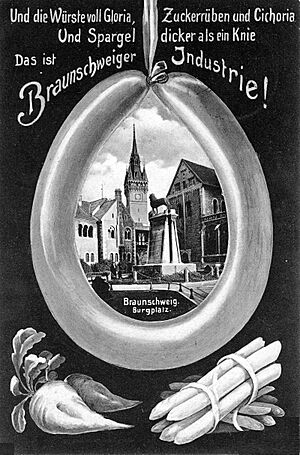
Braunschweig is famous for Till Eulenspiegel, a funny medieval trickster who played many jokes on the city's people.
The city also has a special kind of beer called Mumme, which was first made in 1390. It's a malt extract that used to be shipped all over the world. Two large breweries still operate in Braunschweig today.
Some traditional local foods include Braunschweiger Mettwurst (a soft sausage), white asparagus, Braunschweiger Lebkuchen (gingerbread), and Braunkohl (a type of kale served with sausage).
Media
Braunschweig's main local newspaper is the Braunschweiger Zeitung, which started in 1946. There's also a large radio transmitter near Braunschweig that broadcasts the Deutschlandfunk program.
Festivals
Schoduvel is a medieval form of carnival that was celebrated in Braunschweig as early as the 1200s. Since 1979, a big annual parade called Schoduvel is held in Braunschweig, which is the largest carnival parade in Northern Germany.
An annual Weihnachtsmarkt (Christmas market) takes place in late November and December in the Burgplatz. It's a very popular event, with many visitors each year.
Museums and Galleries
- The Herzog Anton Ulrich Museum is a famous art museum and the oldest public museum in Germany, founded in 1754. It has amazing works by famous artists like Vermeer and Rembrandt.
- The Braunschweigisches Landesmuseum (State Museum of Brunswick) shows the history of the Braunschweig area from ancient times to today.
- The Städtisches Museum Braunschweig (Municipal Museum of Brunswick) focuses on the history of the city itself.
- The Naturhistorisches Museum (State Natural History Museum) is a museum about animals, started in 1754.
- Other museums include the Museum of Photography and the Jewish Museum.
Music and Dance
The Braunschweig Classix Festival used to be an annual classical music festival. It was one of the most important music festivals in Lower Saxony.
Since 2013, the final rounds of the international breakdance competition Battle of the Year have been held in Braunschweig.
The Braunschweiger TSC is a very successful formation dance team. They have won many World and European championships.
Sports in Braunschweig
- Football: Braunschweig's main football team is Eintracht Braunschweig. They won the German football championship in 1967. They play in the 2. Bundesliga, which is the second-highest league in Germany. Braunschweig is also believed to be the city where the first football game in Germany was played! A local teacher named Konrad Koch brought the game here in 1874 and wrote down the first German rules.
- American Football: The New Yorker Lions (formerly Braunschweig Lions) are the city's American football team. They have won a record 12 German Bowl titles and five Eurobowls.
- Basketball: The city's professional basketball team, the Basketball Löwen Braunschweig, plays in Germany's top league.
- Handball: The oldest sports club in the city, MTV Braunschweig, plays in a semi-professional handball league.
Braunschweig also hosts annual sports events like the Löwen Classics (an equestrian tournament) and the Sparkassen Open (a professional tennis tournament).
Twin Towns and Sister Cities
Braunschweig has special partnerships with cities around the world. These are called twin towns or sister cities:
- Bandung, Indonesia (since 1960)
- Nîmes, France (since 1962)
- Bath, England (since 1971)
- Sousse, Tunisia (since 1980)
- Kiryat Tiv'on, Israel (since 1985)
- Magdeburg, Germany (since 1987)
- Kazan, Russia (since 1988)
- Omaha, United States (since 1992)
- Zhuhai, China (since 2011)
Notable People from Braunschweig
Many interesting people have come from Braunschweig or lived there:
- Hermann Blumenau (1819–1899), who founded the city of Blumenau in Brazil.
- Caroline of Brunswick (1768–1821), who became the Queen of King George IV of the United Kingdom.
- Richard Dedekind (1831–1916), a famous mathematician.
- Carl Friedrich Gauss (1777–1855), one of the greatest mathematicians of all time.
- Henry the Lion (1129–1195), a powerful duke who made Braunschweig his capital.
- August Heinrich Hoffmann von Fallersleben (1798–1874), a poet who wrote the German national anthem.
- Gotthold Ephraim Lessing (1729–1781), a very important German writer and thinker.
- Otto IV of Brunswick (1175–1218), who became a Holy Roman Emperor.
- Agnes Pockels (1862–1935), a chemist.
- Dennis Schröder (born 1993), a professional basketball player in the NBA.
- Louis Spohr (1784–1859), a well-known composer.
- Henry E. (1797–1871) and C. F. Theodore Steinway (1825–1889), who founded the famous Steinway piano company.
Images for kids
 In Spanish: Brunswick para niños
In Spanish: Brunswick para niños


